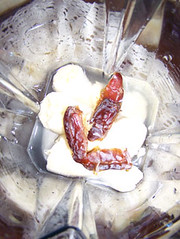
The new Vitamix container arrived within two days (they knew we were hard core Vitamix users and put the container in the mail the day we ordered it to replace the broken one). So, what was the first thing we made in our shiny new container (after washing it, of course)? A DELICIOUS coconut smoothie!




Last week for Take the Time Tuesday, I introduced you to a resource for meeting others in your local community. Today, I'd like to introduce you to an amazing place to meet others all over the world who are interested in raw foods!
Take the time to meet...

It's a beautiful day here. The sun is actually shining enough through the clouds to soak up some of its lovely rays. It feels so good. What a great way to start the weekend! We have no set plans, other than a trip to the local food co-op and a visit from the bunny. If the weather continues to be this nice, maybe we'll take the puppy over to the park and spend the afternoon enjoying the sights, smells, and sounds of Spring.

Hi all-? Jim here from Pure Jeevan with our next eipsode of "Know Your Food."? This is "Episode 2 (salvaged): Turnips."? As far as that "salvaged" parenthetical... This relates to the story I told in our first episode -- about how we're planning to upgrade our video equipment, audio equipment, video editing software, and more. I hope you like it, though. Still working on getting them down to 3-4 minutes. This one's just over 5 minutes. If you're wondering how Wendi became strong as Xena Warrior Princess, you'll have to watch this vid!
So, to summarize:? Turnips are great for the root portion (the turnips, proper) or the greens. (Here at Pure Jeevan, we like to use turnips as shells for rawvioli, or simply sliced and served with a little salt. The greens are great juiced!)? Turnips are starchy, but not as heavy as potatoes, and are a great Vitamin C source. They contain fiber, manganese, pantothenic acid, thiamine, potassium, folic acid, copper, niacin, B6, E, riboflavin, and more. The greens of course have calcium, and are a particularly great source of folate (esp. important for pregnant women) and many of the vitamins and minerals listed previously, along with Vitamin A.

Here it is, the new year. I've never been excited about the end of one year and the beginning of the next, but this time it's different.So many things have changed in our lives here at Pure Jeevan, bringing us to this point in time--a time that we are ready for and fully embrace. This year is going to be RAWmazing!
Many plans and projects have been started over the past few years, and this is the year that will see many of them fully blossom. The beauty of these projects is that they are about so much more than just us, or just you, our lovely readers. Our mission is to help as many people as possible to wake up from a life that's only partially being lived.We believe there are many tools that can be used to fully wake up and embrace life; one of them is eating a raw food diet. We raw foodists know that there is a lot more to life than what we've been taught to believe and expect, and many of us are helping others learn this beautiful fact. We are shaking up many of the core beliefs on which most of us have based our lives. I strongly believe that many of us in the raw food movement can say: We Are The Ones! We are the ones who are here to make positive changes, to help others fully embrace life, and to have fun, fun, fun! Why waste even one more day of your precious life doing something you don't enjoy doing? It's time to have fun, to feel the love that exists within and all around us, and to help others experience the same! So, are you in ?Do you want to join us on this grand adventure of creating a blissful life for not only ourselves, but for the rest of the world, as well?
Read more: Acknowledging Changes and Growth: 2008 / 2009, Part 3
Ketchup
1 cup sun dried tomatoes, soaked for one hour
3 small fresh tomatoes

What do you do when you spend the night or week-end at someone's house and they're not raw. Do you take your blender and all that
Super question, Joanna!? I'm sure you also have a great answer for this. I think I do, too, but it's probably more complicated than a lot of people would like.For me, the factors that complicate the "travel to non-raw households" issue include, but are not limited to:

Thank you, thank you, thank you! Today for Thankful Thursday, we wanted to say a special THANK YOU to our readers. It means so much to us that you come to visit our blog. With every new comment (both here on the blog and through email) it fills us with great happiness!
Is there something you'd like to see more of here on our blog? Something you'd like us to discuss? We know you are looking for more recipes, since you've told us (be sure to check out our recent posts where we've linked to some fantastic sites offering recipes!). What else would you like to read about or have us share with you?

In a previous Take the Time Tuesday entry, we introduced you to three fantastic raw food snack companies who have offered to donate samples of their products for our upcoming retreat. If you haven't heard about the 3-Day Raw Food Spiritual Retreat, yet, there is still some space for you to join us from May 23-25, 2008! We ve set this retreat up so that it s as affordable as possible. There s a significant savings if you sign up early, too, so be sure to check it out!
Each individual attending the retreat will receive a gift basket filled with delicious raw food treats from some truly fantastic companies. Keep an eye on the retreat page to see other companies that will be sharing delicious raw food snacks with those attending the retreat! Today, we'd like you to...

To keep all of you inspired while we are away, we've asked some
remarkable individuals to share their raw food stories with you. Enjoy!

